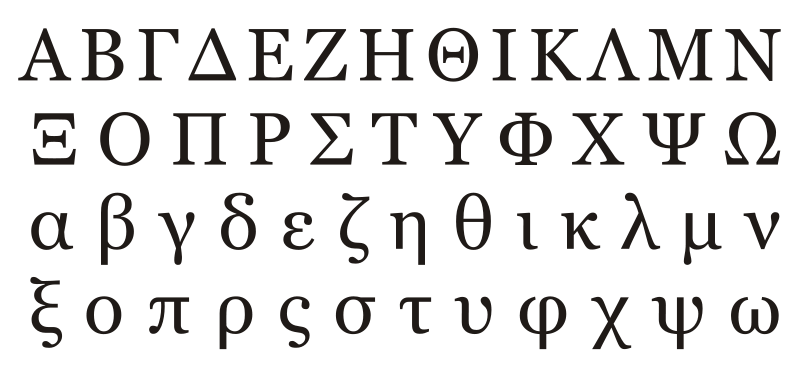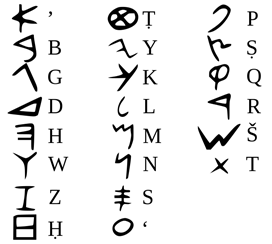
Alphatian Alphabet
by Andrew Tyrus Wieland from Threshold Magazine issue 11Alphatian Alphabet
A [Alpha/Ar] K [Kypri] T [Tar]
B [Beta] Λ [Lambda/Amphi] U [Isla]
Г [Gamma] X [Shu] Ф [Phi/Akasha]
Δ [Delta] M [Mu] Ш [Chi]
Œ [Andru] Ξ [Ksi] Ψ [Psi/Hypno]
Z [Zetta] N [Nu/Nyx] Ω [Om]
H [Eta/Eir] Π [Pi/Mystra] З [Sula]
Θ [Theta] P [Rad/Hast] Ж [Azha]
Y [Yod] Σ [Sud] И [Bury]
Alphatian is customarily written from left to right. It’s a script of 27 characters; 18 consonants, 6 vowels (A, Œ, H, N, Ω, and И), and 2 semivowels (Y and U)1.
Every letter is a symbol of a universal concept. Some of the letters represent months of the year and schools of magic.
Every letter has 2 proper names. If only 1 name is given above it’s usually the Cyprian name. The last 3 letters, Sula, Azha, and Bury, were added after Landfall to represent foreign sounds. They have 2 names but don’t have a secondary pronunciation that’s only used for archaic words.
Image 1: Milenian alphabet

Caption:
The Milenian alphabet, probably a main inspiration for the Alphatian
Alphatian is the language used for spellbooks and magic user scrolls. Spellcasters from different nations that speak different languages don’t pronounce the words of a spell the same way but they will use the same words if both of them got the spell from the same teacher. They will usually know how someone who speaks another dialect would pronounce the words.
Alphatian has changed as the centuries pass and some of the letters that had distinct sounds in the past now sound the same. Some of the original sounds have vanished from the Common tongue as it’s spoken in Vertiloch (which has changed from boar-tae-loch to vair-tee-lock and kept the original spelling of BHRTYΛΩШ).
Image
2: Varellyan alphabet
Caption:
Varellyan alphabet, common in the Alphatian sea before Landfall,
compared to Thyatian sounds
Sages believe Andru (Œ) and Chi (Ш) were added to the Alphatian Alphabet shortly after the conquest of the Cyprians. Some sages believe Nu/Nyx (N) was a consonant.
Every letter has an opposite that negates it. Alpha (beginnings) is negated by Omega (endings). Sula (animal or beast) was added to the Alphabet to negate Beta (plant or tree). Azha may represent chaos, wilderness, or a waste land. It was added to negate Gamma. Delta (light) is opposed by Shu (darkness).
Akasha negates Myst because memory resolves questions. Psi negates Akasha because dreams interfere with memory. Myst negates Akasha because questions engage the mind and disrupt a trance. For the other 12 cases, negation means almost the same thing as opposite.
Chi sounds like Kypri in the most common dialect of Alphatian. It was a guttural 'k' in the original Sundsvall dialect. Spellcasters might say both letters the same way when they're talking but they would be sure to say them differently when they're chanting.
Spellcasters might use Myst in a confusion spell and Phi in a dispel confusion spell but they're more likely to use Eir and Ksi because Ksi marks the spot.
Spellcasters would use Delta in a light spell and Shu in a darkness spell. If they used both it would probably be a wasted effort.
Many spells have a reversed version. Tar would be used in the slow spell because it negates Rad/Hast. Ksi would be used in detect invisible.
Zetta and Sula might also sound the same.
Bury (cold or undead) was added to negate Andru (entity). The 5th letter represents intelligent life in any form and may not imply literacy or speech. It may be extended to goblins, hutaakans, and peasants along with elves and humans.
Pi or Mystra represents women, circles, and mysterious things. Phi or Akasha represents memory and negates it. Pi won’t work to counter the influence of Phi in a spell but Psi or Hypno (dreams) must be used. Pi will negate Psi.
Eir may represent mist but it’s more commonly used to represent deception or hidden things. It negates and is negated by Ksi, which represents truth and openness.
Kypri may represent bravery or skill. It negates and is negated by Chi, which is called Hollow and often means boastful or vainglorious.
Amphi represents the deep and Nyx the firmament, they negate each other. Yod negates and is negated by Mu. Zetta negates and is negated by Isla. Theta (infinity or the immortals) negates and is negated by Sud (addition). Rad (rebel) negates and is negated by Tar (tyrant). The true meaning for all of these symbols is debatable.
II. The History of
Alphatia
Sunville (ΣNBHΛ) was known as Fort Abel (ABHΛ) before it became a town, the City of Sundown, and finally the Capital City of Sundsvall.
Sages that study Fort Abel add that Greenwood (originally spelled BABA) was known as Fort Babel (BABHΛ) or Betaville (BHTABHΛ). It was built to the northeast on the shores of a lake that the Yanifey called Llyn.
Zettaville (ZHTABHΛ) was founded in the same year as Fort Abel and it came to be called Citadel. It became the capital of a nation when the King of Bettelyn (BHTAΛY) petitioned the Emperor of Ar as a fellow sovereign. Theranderol (ΘHRNΔHRΩΛ) was the next nation to attract a king, who named his capital Errolyn.
Ar, the archmage who built floating islands, arrived with Aasla and Emperor Kerothar. He founded the City of Bluenose with seven other archmages. He founded the City of Sepphoris and raised a Hanging Palace for the Emperor.
Vertiloch was recognized as a kingdom about a century after the King of Theranderol took his place beside the monarchs of Ar and Bettelyn. The people of Sundsvall saw that Citadel had grown wealthy as it gained influence and they wanted the same benefits.
Each of the 4 kingdoms favored a magical discipline but wasn’t organized into an actual school. Each of them had their own symbols. The Alphatians believed there were 12 magical disciplines but didn’t agree on their names.
Arogansa petitioned the Imperial Court when Sepphoris became the capital of Ar. Foresthome, Greenspur, and Shiye-Lawr were autonomous regions for a long time before they were formally recognized. Haven was a duchy for almost a century.
Arogansa, Foresthome, and Haven chose appropriate symbols to rival the 4 kingdoms. Randel started its own School of Magic and seceded from the Kingdom of Theranderol. Bluenose and Errolyn built schools in related disciplines. Haven was opposed to the militant attitude of Randel and didn’t build a school in its favored discipline. Foresthome built a school in the wilderness that taught mind tricks and was more popular than the 3 schools of war studies.
Ar corresponds to divination, the hue of azure, and the stone of turquoise. Sepphoris is its capital. Bettelyn corresponds to conjuration, the hue of ebony, and the stone of onyx. Citadel is its capital. Theranderol corresponds to evocation, the hue of gold, and the stone of topaz. Errolyn is its capital. Vertiloch corresponds to alteration, the hue of emerald, and the stone of jade. Sundsvall is its capital.
Arogansa corresponds to necromancy, the hue of silver, and the stone of crystal. Bluenose is its capital. Foresthome corresponds to illusion, the hue of bronze, and the stone of amber. Greenwood is its capital. Haven corresponds to enchantment, the hue of ruby, and the stone of jasper. Aasla is its capital.
Ambur, the next kingdom to be recognized, established a School of Fine Arts that didn’t train spell casters. Shiye-Lawr was finally recognized as a kingdom. Greenspur was recognized and established a School of Aviation that accepted fighters, magic users, and clerics. Skyreach, Alfeish, and Eagret are the primary cities. Alfeish seems like a young city when compared to Citadel because it never had a construction boom or bust, and because most of the natives are elves that can live for 800 years or more.
Limn was conquered and became a kingdom nearly 5 centuries after Landfall. Its capital, Trollhatten, is a relatively young city. Blackheart and its capital of Shraek were established by refugees from Limn. It attracted potion brewers who sought privacy. They met with arcane crafters and potion brewers and found common ground. The 3 factions established a private school of item creation.
Eadrin, Frisland, Stonewall, and Stoutfellow are the young nations of Alphatia and their primary cities are Archport, Shiell, Draco, and Denwarf-Hurgon.
III. The Alphatian
Schools of Magic
Not all of the 8 schools of magic have or should have physical locations. Magic users should have access to spells from every school but many spells are considered trade secrets and seldom taught to anyone except for specialists. All specialists should have access to the School of Divination to get detect magic and read magic.
Specialists in the School of Abjuration are called banishers. Specialists in the School of Enchantment are called beguilers. The other schools train diviners, illusionists, invokers, necromancers, summoners, and transmuters.
Specialists in a magical school take on of the letters of the Alphatian Alphabet as a symbol. Specialists in alteration, conjuration, divination, and evocation use the letters Λ, N, A, and K. They have more prestige than the other schools.
Specialists in the School of Necromancy tend to be unpopular in most places. Thothia (the Dominion of the Immortals) is a notable exception. They use И as a symbol. Specialists in abjuration, enchantment, and illusion use P, U, and H.
In Alphatia, scholars who study animal life are called naturalists and scholars who study plant life are called herbalists. Some naturalists are beguilers and some of them don’t cast spells. All of them use U as a symbol. Druids and herbalists use B as a symbol. Druids don’t benefit from formal studies and some of them aren’t even literate.
Artificers, shape changers, and snake charmers are obscure schools of magic that used Œ, З, and Σ as symbols. They’re mentioned because they correspond to the other letters of the Alphabet that give names to the months.
Bards, clerics, and magic users are sometimes included as schools of magic. Bards and clerics don’t learn how to cast more spells by taking classes. Magic users don't agree on what letter should symbolize the 10th class, the reasons why are complicated. They agree that clerics are the 12th class and they should use Theta as a symbol.
Specialists get better spells in their own schools and don’t have access to 2 opposed schools of magic. Diviners don’t get conjuration or evocation spells. Necromancers don’t get enchantment or illusion spells. The other schools don’t get necromancy spells and spells from 1 other school. Abjuration and enchantment are opposed schools. Alteration and conjuration are opposed schools. Evocation and illusion are opposed schools.
1For the alphabet, I used 22 Greek letters, 4 Cyrillic letters, and 1 modified Greek-Latin letter.